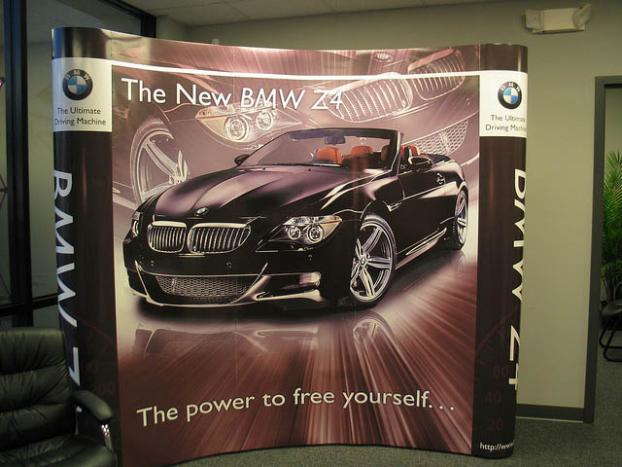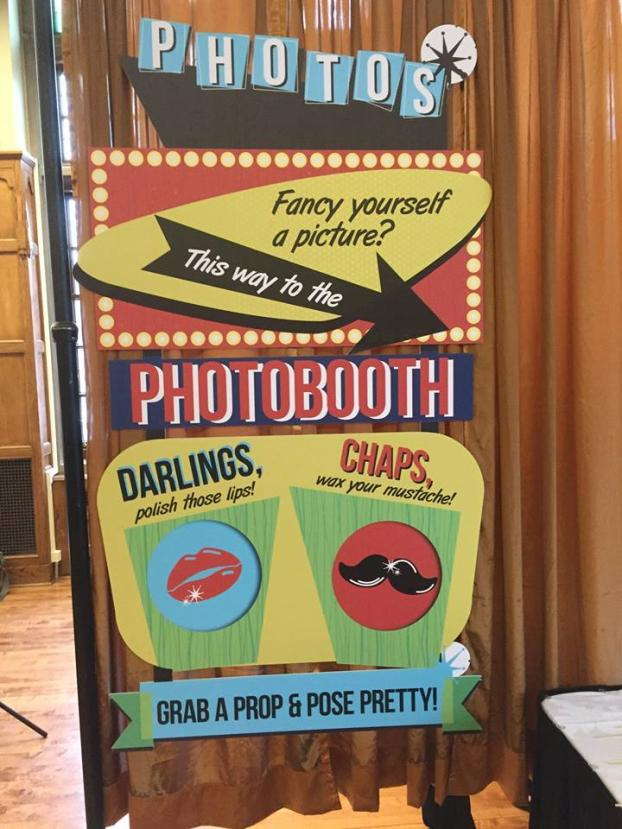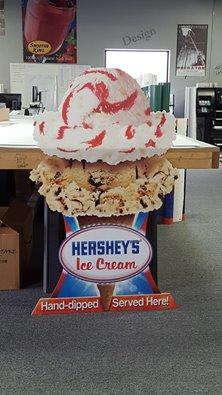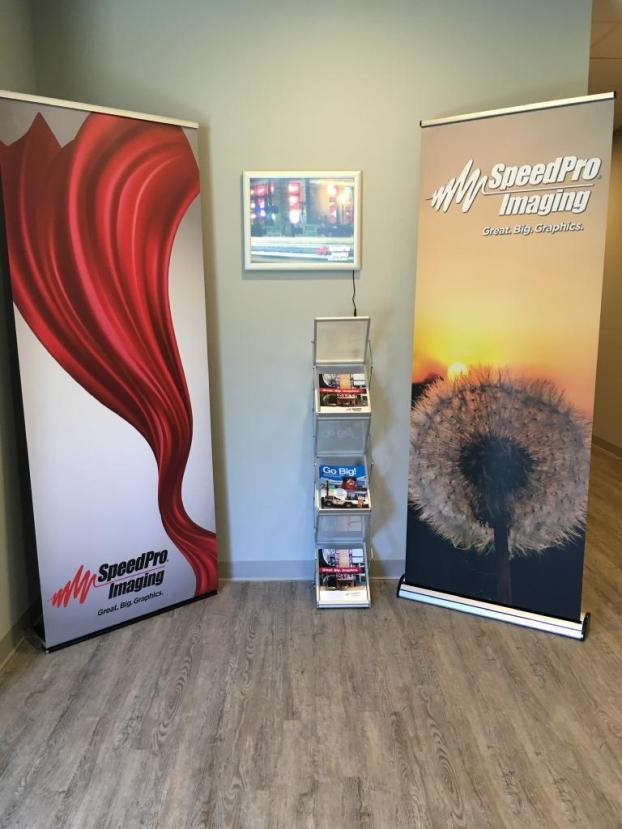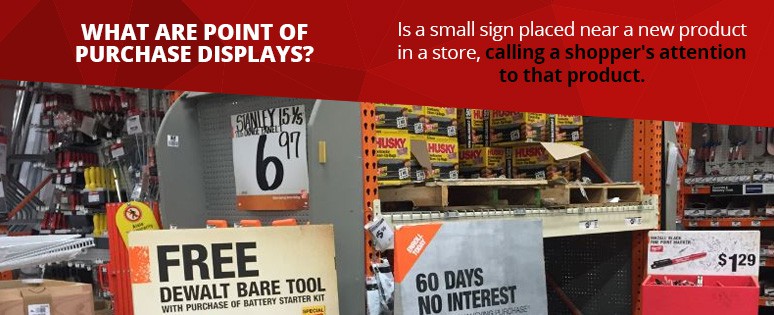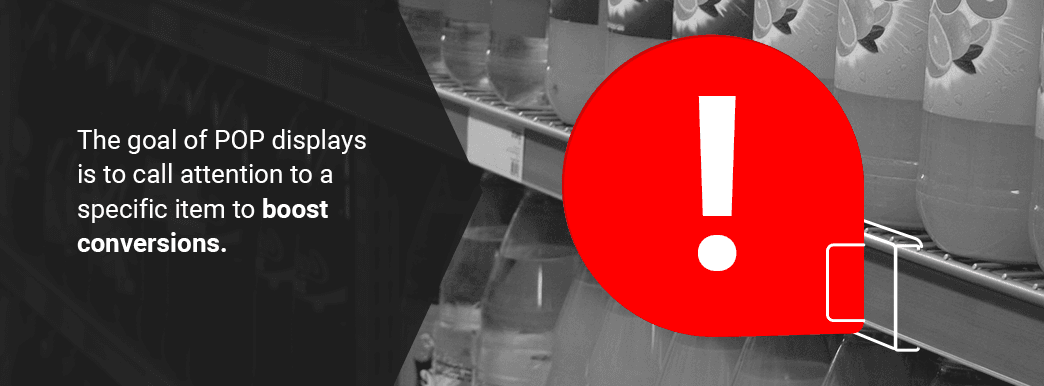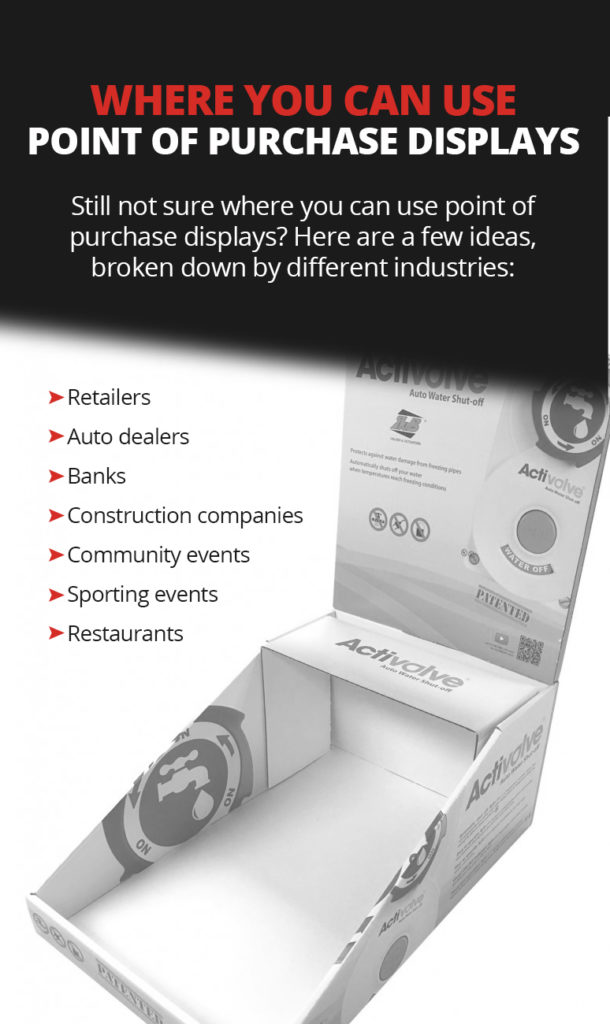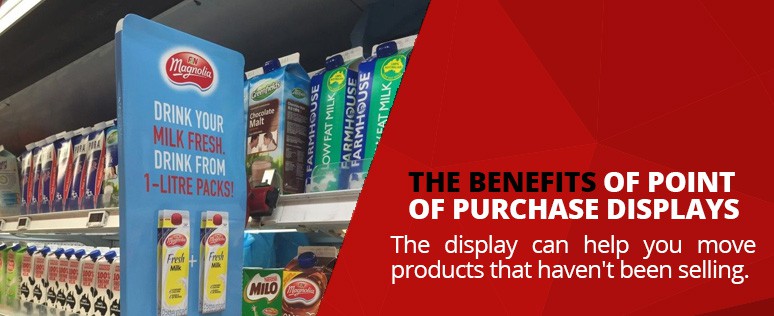Custom Point of Purchase Displays
When a customer walks through your store, around your trade show display or into your restaurant, you have multiple chances to convince them that your product or service is what they need. Signs and displays can bring people into your business, but what can you do to keep them once inside?
Point of purchase marketing is one way to turn people who might be “just browsing” and curious about your company into paying customers. Point of purchase (POP) marketing can take multiple forms and involve giving people a sample of a product to try or even demonstrating a product. In-store product sampling has a direct connection to an increase in sales.
Another form of POP marketing is point of purchase displays, as they can be used along with other marketing tactics — such as product demos or samples — or they can be the sole focus of your marketing efforts.
What Are Point of Purchase Displays?
Point of purchase displays (pop display) are typically placed near the promoting item as a specific POP marketing strategy. The goal of POP displays is to call a customer’s attention to a specific item to boost conversions. Often, brands will use POP displays to differentiate their items from almost identical or similar products.
POP displays work best when they appeal to customers’ interests. While different businesses might have similar products, they may take a different approach when using POP displays to appeal to their customers directly. For example, an auto shop might use a POP display showing a shiny car to sell their microfiber clothes, while a grocery store that sells the same product may use a POP display showing sparkling glassware. POP displays are more effective when designed with a specific audience in mind.
When designing a POP display, a good strategy is to think about a narrative, and what story do you want to tell your customers with the display? For example, displaying photos of workout clothing on smiling models performing activities like hiking and biking sells a narrative that those who wear the clothing are active and happy.
Examples of POP Displays
Point of purchase displays can take various forms from endcap displays, a shelf or floor display, countertop display, pallet display, permanent displays to temporary pop display signage. Usually, the displays are next to the items they’re promoting.
One example of a point of purchase display is a small sign placed near a new product in a store or retail setting, calling a shopper’s attention to that product. For example, if a grocery store gets a new product, a custom point of purchase sign on the shelf can grab attention and provide more details about the new item.
Another point of purchase display is a ceiling mobile inside a store or at a trade show or convention. Mobiles call attention to a new product and help people find their way to your company’s trade show, expo booth, or navigate their way to the product in question.
Similarly, a point of purchase display can include a stand-alone sign with the product’s name to separate the product from the other items for sale. A business can place a retail display to set the new item apart to grab customers’ attention.
In some cases, a point of purchase display might be located near the checkout area. While people are waiting in line, they’re likely to look at the products and make an impulse purchase in the best-case scenario.
Custom POP Display Features
The most effective purchase displays have a few common features. For example, a sign is often part of a POP display that contains the product’s name and any details about what it is or acts as a sale display. In some cases, POP signs go further and seek to explain exactly why the product is needed. The display can also help the customer decide which item in a product line is the best option.
Some of the other components that you might include in custom point of purchase displays are:
- Sectional fabric wall panels: Some point of purchase displays are quite large. If you’re looking to cover a wall at a trade show or have a wall in your store that’s free, sectional fabric wall panels can make sense. They easily join together to configure professional POP displays along aisles or around corners.
- Wall displays: Wall displays are ideal for portable point of purchase displays. For example, if you’re showing your products at an expo or setting up a pop-up store, wall displays can come together quickly and provide an ideal location for showing off your products.
- Printed fabric panels: You can hang printed fabric panels from the wall to create a large backdrop for the rest of your display.
- Attachable shelf display: If you have products that you want to incorporate into your point of purchase display, shelving that you can adjust as needed is a must.
- Tablet stands or kiosks: The point of purchase can also include the point of sale location, such as the checkout counter. A table stand or kiosk is ideal for that last step in the purchase funnel.
- Window clings and contour cut vinyl cutouts: Depending on your location, your display can feature elements on the window or glass of your store or restaurant to promote brand awareness.
- Easel-back standups: A life-size cutout can be an eye-catching component in a point of purchase display. The cutout can be of the spokesperson for the brand or a larger-than-life figure of the product itself.
Restaurants and other businesses in the hospitality industry, such as pubs, cafes, hotels, and kiosks (known collectively as HORECA), have a few more options for using point of purchase displays. In many cases, a company will pay a restaurant or similar business to have its branded displays featured in the point of purchase area. If you’ve ever seen a pint glass with a printed beer brand printed or enjoyed a meal on a restaurant’s patio under a branded umbrella, you’ve seen HORECA point of purchase displays in action.
Point of Purchase vs. Point of Sale
The terms “point of purchase” and “point of sale” (pos display) are sometimes used interchangeably. Although the two terms have some things in common — namely, the point at which a person makes a purchase — there are some critical differences.
Perhaps the most crucial difference between the two is location. “Point of sale” is often used to refer to the exact spot where a customer pays for a product or service and the sale is pretty much complete. Online, the point of sale area can be the shopping cart and checkout section. In a brick-and-mortar location, the cash register or checkout line is usually the point of sale.
The point of purchase can be throughout a brick-and-mortar location. It’s where someone decides to buy something, whether it’s a new dress, a different type of coffee, a special offer at a restaurant, or a cleaning service subscription. The point of purchase can be located near the point of sale or located somewhere else in the business.
In some instances, the point of purchase is located at multiple points across a business. For example, a restaurant might have a signboard advertising its specials as people enter the waiting area. Once seated, they might see the specials and a description of them listed on a chalkboard, sign on the wall or a table tent to draw attention to the special.
Where You Can Use Point of Purchase Displays
Still not sure where you can use point of purchase displays? Here are a few ideas, broken down by different industries:
- Retailers: Retail stores can have point of purchase displays throughout their establishment. The displays can highlight new products or help retailers move items that might be slow to sell otherwise.
- Auto dealers: A car dealer can have a point of purchase display set up in the middle of a showroom. The display can describe current sales or special offers, such as limited-time financing. It can also describe the vehicles available from the automaker and explain what makes each one different.
- Banks: A bank can set up a point of purchase display to explain the benefit of taking out a mortgage or another type of loan. It can also use displays to detail the perks of its checking or savings accounts to people.
- Construction companies: A construction company can use a point of purchase display in a model home to highlight the benefits of buying one of its building properties. An expo or convention, such as a home show, can use displays to attract people to its booth and provide more information to potentially interested buyers.
- Community events: Community event organizers can use point of purchase displays to encourage participation. For example, displays directing people to a photo booth or dunking booth at a community fair can convince people that they want to get their picture taken or spend a few dollars for the chance to dunk someone in a pool of water.
- Sporting events: There are a few areas where a point of purchase display can be effective during a sporting event. For example, the concession vendors can use displays to attract people looking for a snack to nibble on. The merchandise vendors can use displays, such as a life-size team mascot, to get people to stop and browse and ideally buy a t-shirt or two.
- Restaurants: Restaurants can use point of purchase displays to upsell diners or get customers interested in buying products from certain brands, such as a particular winemaker, brewery or soda company.
- Furniture stores: A store selling large furniture like bedroom sets and couches can use point of purchase displays to upsell features like delivery and assembly. A sign next to a large sectional couch for a deal on the delivery and assembly costs might influence a customer’s decision to use their services.
Point of Purchase Display Benefits
Imagine you’re wandering the aisles of your local grocery store. You’ve been there so many times you’ve lost count, and you usually buy the same things. But today, as you walk down the soup aisle, a colorful sign catches your eye. It’s placed under an arrangement of soup cans that you’ve never seen before. You’re intrigued, so instead of quickly grabbing your go-to soup brand, you take a closer look—the sign details what’s different about the new soup and its benefits.
Breaking people out of their “same old, same old” routines is just one of the benefits of point-of-purchase displays. Another benefit is that the display can help you move products that haven’t been selling. To go back to the soup example, it could be that the soup isn’t exactly a “new offering,” but something the grocery store has had difficulty selling, perhaps because shoppers are likely to buy what they’re already familiar with.
POP displays don’t just direct people’s attention to a product, and they can also educate consumers. Depending on the size of the display, it can include lots of details or even a FAQs list explaining what makes the new product worth someone’s time and money.
Point of purchase displays also appeals to people’s impulse-buying nature. People might shop with a list, but it’s often more fun to make a surprise purchase or two — so much that people spend more than $5,000 on impulse purchases each year. It’s a huge market that retailers certainly want to take advantage of. If there’s an eye-catching display showing off something that’s a novelty to a shopper, they might just buy it.
Point of purchase displays are pretty flexible. You can choose a small tabletop display to highlight specials at a restaurant or go big and select a display covering the walls and windows to announce a new product line or launch a new and exciting service.
You can fully customize the size and complexity of your POP display to match your particular needs. In fact, targeted advertising is enormously successful and it builds customer interest and generates conversions at a much higher rate than traditional advertising methods. Point of purchase displays are a great method to use targeted advertising, as companies can tailor their design to feature products in ways that attract their customer base.
Make the Most of Your Point of Purchase Display
The POP display options available from SpeedPro can be accented with attachable, adjustable LEDs, spots or other light options. Incorporating lighting in your POP displays can draw increased attention from potential customers, and lights catch the eye and elevate any display’s quality.
Customize one of our versatile truss displays exhibit structures held together by sleek and sturdy metal frames for a stronger presence. No assembly tools are required, and setup is quick and simple. Complete your POP display with attention-grabbing graphics on backlit pop-ups with optional lighting and a custom display counter available in several shapes and sizes.
POP displays are more than making a quick profit. Your point of purchase is the face you show to prospective clients, interested investors, and intrigued visitors. You need it done right the first time to look right every time. When you partner with SpeedPro, you can trust that we’ll ask you the important questions and suggest the best choices so that your POP display will last as long as you need.
SpeedPro: Your Partner Printers
No matter what you’re displaying for purchase, SpeedPro can help you give it the kind of attention that leads to sales. Our nationwide network of studios has a long history of successful POP display campaigns and can offer a solution built for you.
In addition to POP displays, we also create trade show displays and vehicle wraps, event graphics, window graphics and more. We’ll work with you to bring your ideas to life and produce attention-grabbing graphics that meet your needs. To learn more, find the SpeedPro studio nearest you today.

















